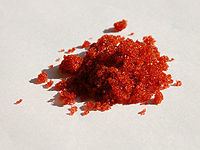Formula Co(NO3)2 Melting point 100 °C | Molar mass 182.943 g/mol Density 2.49 g/cm³ | |
 | ||
Appearance pale red powder (anhydrous); red crystalline (hexahydrate) | ||
Cobalt Nitrate is the inorganic cobalt(II) salt of nitric acid, often with various amounts of water. It is more commonly found as a hexahydrate, Co(NO3)2·6H2O, which is a red-brown deliquescent salt that is soluble in water and other polar solvents.
Contents
Composition and structures
As well as the anhydrous compound Co(NO3)2, several hydrates of cobalt(II) nitrate exist. These hydrates have the chemical formula Co(NO3)2·nH2O, where n = 0, 2, 4, 6.
Anhydrous cobalt(II) nitrate adopts a three-dimensional polymeric network structure, with each cobalt(II) atom approximately octahedrally coordinated by six oxygen atoms, each from a different nitrate ion. Each nitrate ion coordinates to three cobalts. The dihydrate is a two-dimensional polymer, with nitrate bridges between Co(II) centres and hydrogen bonding holding the layers together. The tetrahydrate consists of discrete, octahedral [(H2O)4Co(NO3)2] molecules. The hexahydrate is better described as hexaaquacobalt(II) nitrate, [Co(OH2)6][NO3]2, as it consists of discrete [Co(OH2)6]2+ and [NO3]− ions. Above 55 °C, the hexahydrate converts to the trihydrate and at higher temperatures to the monohydrate.
Uses
It is commonly reduced to metallic high purity cobalt. It can be absorbed on to various catalyst supports for use in Fischer-Tropsch catalysis. It is used in the preparation of dyes and inks.
Production
The hexahydrate is prepared treating metallic cobalt or one of its oxides, hydroxides, or carbonate with nitric acid:
Co + 4 HNO3 + 4 H2O → Co(H2O)6(NO3)2 + 2 NO2CoO + 2 HNO3 + 5 H2O → Co(H2O)6(NO3)2CoCO3 + 2 HNO3 + 5 H2O → Co(H2O)6(NO3)2 + CO2